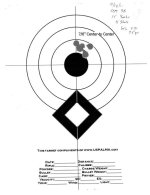On Sunday I shot identical loads through three revolvers and was surprised that my Colt Officers Model 38 (6" barrel) was much less consistent statistically compared to two other pistols. One is a S&W Model 66-2 (.357 Mag chambers) with a 3" barrel. The other is a S&W Model 642 with a 1-7/8" (nominal) barrel.
66-2: Avg 656 Spread 56 Std Dev. 16.9
642: Avg 619 Spread 55 Std Dev 18.5
OM 38: Avg 701 Spread 75 Std Dev 24.9
Powder: Win 231 3.3 grains
Bullet: 148gr. Hornady HBWC
Primer: CCI Small Pistol #500
All cartridges were loaded at the same time in the same cases (once fired UMC). I load powder using trays and check every 5-10 rounds afterward for consistency when working up a new load like this.
My accuracy was better with the S&W 66-2 than the Colt but that doesn't mean much since I wasn't shooting off a rest. However, the extreme spread and standard deviation are very close for the two S&Ws despite the difference in barrel length while the same stats for the Officers Model are almost 50% higher.
Results were similar with a 3.1 grain load in terms of the two S&W revolvers producing very similar extreme spreads and standard deviations, with the longer barrel Colt being more inconsistent.
Is it possible this indicates a timing issue or something else I should look for?
I realize that the powder is taking up very little of the available case volume. Someone else suggested making sure that I point the gun upward after cocking it and lower gently toward the target to get more consistent powder placement in the case. However, why would that affect the 6" barreled gun more than the other two?
Could it be the clockwise rotation of the Colt's cylinder? (that's a joke BTW)
While I'm lost in the weeds, my Hornady manual shows a velocity of 750 fps for this load out of a 4" barrel. I expected a slightly higher velocity from my 6" barrel, not slower. I know that there are a lot of variables so am not sweating this much.
Thanks for your thoughts.
If you already saw my questions on another forum, forgive me. This forum seems to have more traffic and I'm still puzzled by these results.
66-2: Avg 656 Spread 56 Std Dev. 16.9
642: Avg 619 Spread 55 Std Dev 18.5
OM 38: Avg 701 Spread 75 Std Dev 24.9
Powder: Win 231 3.3 grains
Bullet: 148gr. Hornady HBWC
Primer: CCI Small Pistol #500
All cartridges were loaded at the same time in the same cases (once fired UMC). I load powder using trays and check every 5-10 rounds afterward for consistency when working up a new load like this.
My accuracy was better with the S&W 66-2 than the Colt but that doesn't mean much since I wasn't shooting off a rest. However, the extreme spread and standard deviation are very close for the two S&Ws despite the difference in barrel length while the same stats for the Officers Model are almost 50% higher.
Results were similar with a 3.1 grain load in terms of the two S&W revolvers producing very similar extreme spreads and standard deviations, with the longer barrel Colt being more inconsistent.
Is it possible this indicates a timing issue or something else I should look for?
I realize that the powder is taking up very little of the available case volume. Someone else suggested making sure that I point the gun upward after cocking it and lower gently toward the target to get more consistent powder placement in the case. However, why would that affect the 6" barreled gun more than the other two?
Could it be the clockwise rotation of the Colt's cylinder? (that's a joke BTW)
While I'm lost in the weeds, my Hornady manual shows a velocity of 750 fps for this load out of a 4" barrel. I expected a slightly higher velocity from my 6" barrel, not slower. I know that there are a lot of variables so am not sweating this much.
Thanks for your thoughts.
If you already saw my questions on another forum, forgive me. This forum seems to have more traffic and I'm still puzzled by these results.





